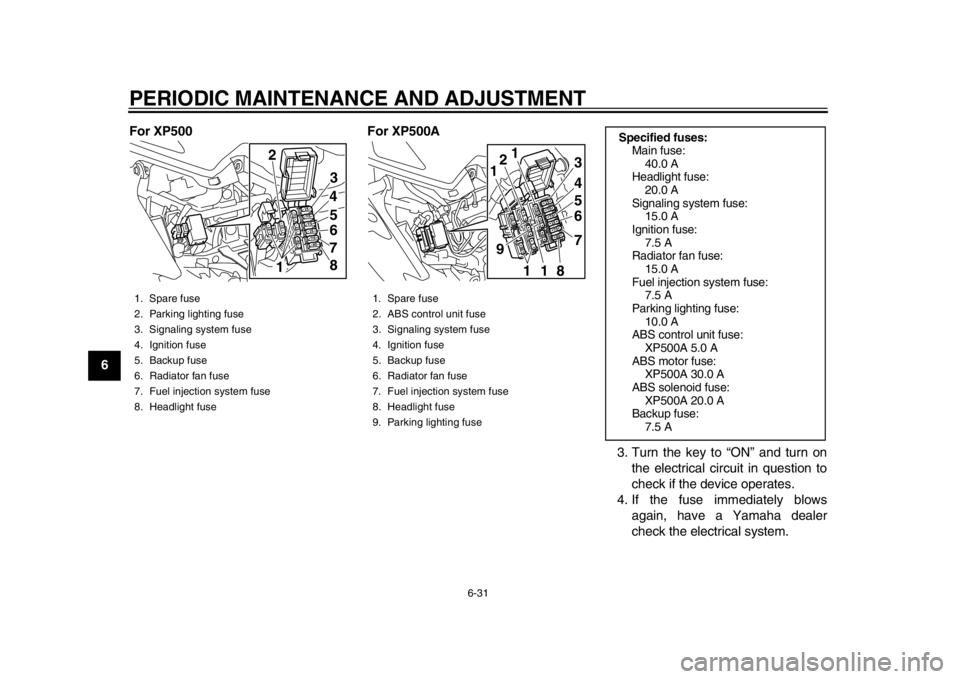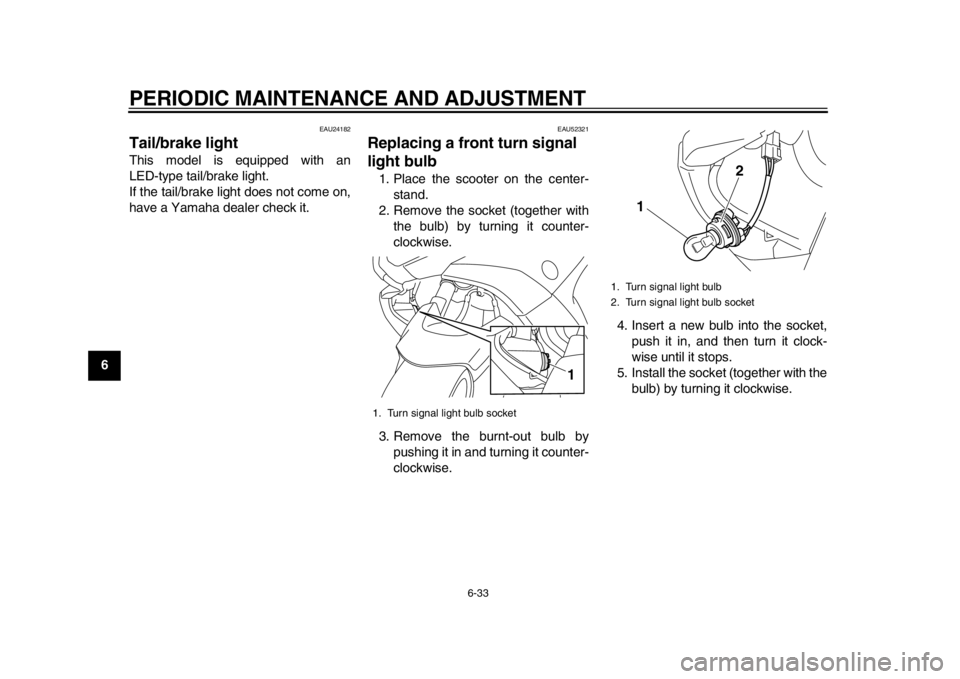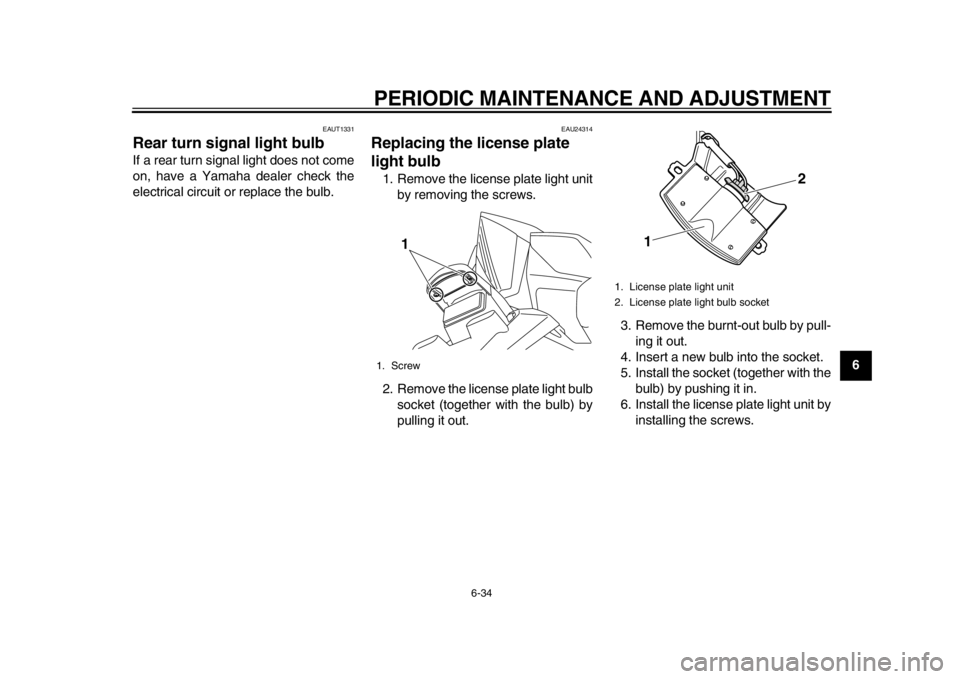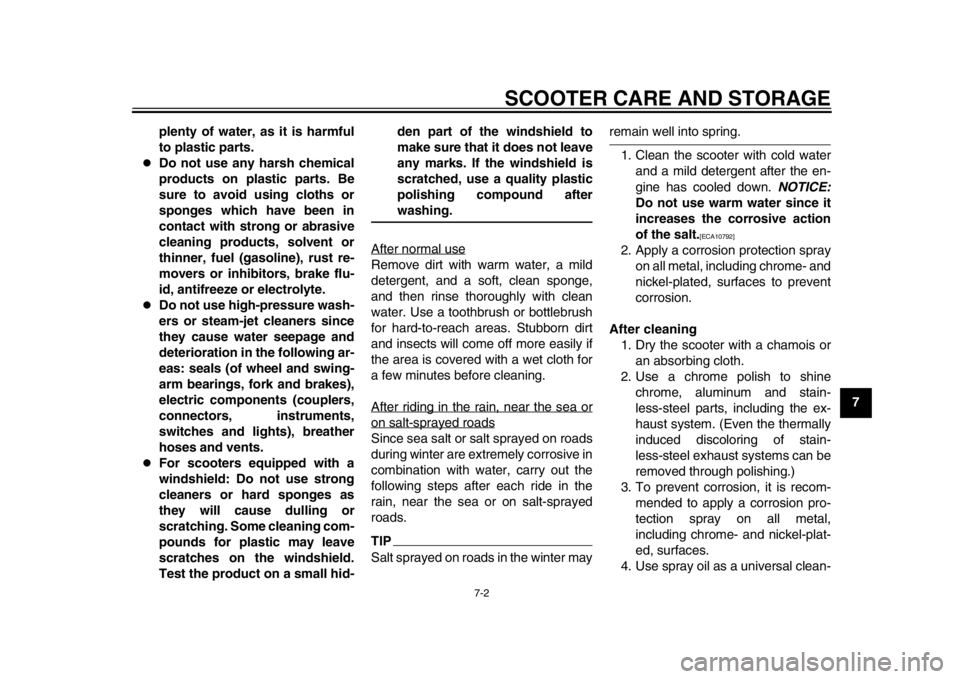light YAMAHA TMAX 2014 Owner's Manual
[x] Cancel search | Manufacturer: YAMAHA, Model Year: 2014, Model line: TMAX, Model: YAMAHA TMAX 2014Pages: 100, PDF Size: 3.01 MB
Page 59 of 100

PERIODIC MAINTENANCE AND ADJUSTMENT
6-10
2
3
4
567
8
9
To install the panel
Place the panel in the original position,
and then install the screws.
EAU19643
Checking the spark plugsThe spark plugs are important engine
components, which should be checked
periodically, preferably by a Yamaha
dealer. Since heat and deposits will
cause any spark pl
ug to slowly erode,
they should be removed and checked
in accordance with the periodic mainte-
nance and lubrication chart. In addition,
the condition of the spark plugs can re-
veal the condition of the engine.
The porcelain insulator around the cen-
ter electrode of each spark plug should
be a medium-to-light tan (the ideal color
when the vehicle is ridden normally),
and all spark plugs installed in the en-
gine should have the same color. If any
spark plug shows a distinctly different
color, the engine could be operating im-
properly. Do not attempt to diagnose
such problems yourself. Instead, have
a Yamaha dealer check the vehicle.
If a spark plug shows signs of electrode
erosion and excessive carbon or other
deposits, it should be replaced. Before installing a spark plug, the spark
plug gap should be measured with a
wire thickness gauge and, if necessary,
adjusted to specification.
Clean the surface of the spark plug
gasket and its mating surface, and then
wipe off any grime from the spark plug
threads.
TIPIf a torque wrench is not available when
1. Screw
2. Panel D
1
2
1
Specified spark plug:
NGK/CR7E
1. Spark plug gapSpark plug gap:0.7–0.8 mm (0.028–0.031 in)
Tightening torque: Spark plug:13 Nm (1.3 m·kgf, 9.4 ft·lbf)
59C-9-E2.book 10 ページ 2013年6月18日 火曜日 午後1時33分
Page 60 of 100

PERIODIC MAINTENANCE AND ADJUSTMENT
6-11
1
2
3
4
56
7
8
9installing a spark plug, a good estimate
of the correct torque is 1/4–1/2 turn
past finger tight. However, the spark
plug should be tightened to the speci-
fied torque as soon as possible.
EAU1985D
Engine oil and oil filter
cartridgeThe engine oil level should be checked
before each ride. In addition, the oil
must be changed and the oil filter car-
tridge replaced at the intervals speci-
fied in the periodic maintenance and
lubrication chart.
To check the engine oil level
1. Place the vehicle on the center- stand. A slight tilt to the side can
result in a false reading.
2. Start the engine, warm it up for two minutes, and then turn it off.NOTICE
ECA11291
The engine must be cold before pro-
ceeding with the oil level check, oth-
erwise the check will result in a falsereading.
3. Wait two minutes until the oil set- tles, and then check the oil level
through the check window located
at the bottom-left side of the crank-
case.
TIPThe engine oil should be between theminimum and maximum level marks.
4. If the engine oil is below the mini- mum level mark, add sufficient oil
of the recommended type to raise
it to the correct level.
To change the engine oil (with or
without oil filter cartridge replace-
ment) 1. Place the vehicle on a level sur- face.
2. Start the engine, warm it up for several minutes, and then turn it1. Engine oil level check window
2. Maximum level mark
3. Minimum level mark
1
23
59C-9-E2.book 11 ページ 2013年6月18日 火曜日 午後1時33分
Page 63 of 100

PERIODIC MAINTENANCE AND ADJUSTMENT
6-14
2
3
4
567
8
9
been reached), the indicator must be
reset after the oil change for the next
periodic oil change to be indicated at
the correct time.
EAU20071
CoolantThe coolant level should be checked
before each ride. In addition, the cool-
ant must be changed at the intervals
specified in the periodic maintenance
and lubrication chart.
EAU52021
To check the coolant level
1. Place the vehicle on the center- stand.TIP
The coolant level must be checked
on a cold engine since the level
varies with engine temperature.
Make sure that the vehicle is posi-
tioned straight up when checking
the coolant level. A slight tilt to theside can result in a false reading.
2. Check the coolant level through the check window.
TIPThe coolant should be between theminimum and maximum level marks. 3. If the coolant is at or below the
minimum level mark, remove the
left floorboard mat by pulling it up.
4. Remove the coolant reservoir cov-
1. Coolant level check window
2. Maximum level mark
3. Minimum level mark
1. Floorboard mat
2
3
1
1
59C-9-E2.book 14 ページ 2013年6月18日 火曜日 午後1時33分
Page 80 of 100

PERIODIC MAINTENANCE AND ADJUSTMENT
6-31
1
2
3
4
56
7
8
9For XP500 For XP500A
3. Turn the key to “ON” and turn onthe electrical circuit in question to
check if the device operates.
4. If the fuse immediately blows again, have a Yamaha dealer
check the electrical system.
1. Spare fuse
2. Parking lighting fuse
3. Signaling system fuse
4. Ignition fuse
5. Backup fuse
6. Radiator fan fuse
7. Fuel injection system fuse
8. Headlight fuse
3
4
56
7 8
2
1
1. Spare fuse
2. ABS control unit fuse
3. Signaling system fuse
4. Ignition fuse
5. Backup fuse
6. Radiator fan fuse
7. Fuel injection system fuse
8. Headlight fuse
9. Parking lighting fuse
1 2
1
3
5 4
6
7
1
9
18
Specified fuses:
Main fuse:40.0 A
Headlight fuse:
20.0 A
Signaling system fuse: 15.0 A
Ignition fuse: 7.5 A
Radiator fan fuse:
15.0 A
Fuel injection system fuse: 7.5 A
Parking lighting fuse: 10.0 A
ABS control unit fuse:
XP500A 5.0 A
ABS motor fuse: XP500A 30.0 A
ABS solenoid fuse: XP500A 20.0 A
Backup fuse:
7.5 A
59C-9-E2.book 31 ページ 2013年6月18日 火曜日 午後1時33分
Page 81 of 100

PERIODIC MAINTENANCE AND ADJUSTMENT
6-32
2
3
4
567
8
9
EAU52233
Replacing the headlight bulbThis model is equipped with a halogen
bulb headlight. If the headlight bulb
burns out, replace it as follows.NOTICE
ECA10651
Take care not to damage the follow-
ing parts:
Headlight bulb
Do not touch the glass part of
the headlight bulb to keep it free
from oil, otherwise the transpar-
ency of the glass, the luminosity
of the bulb, and the bulb life will
be adversely affected. Thor-
oughly clean off any dirt and fin-
gerprints on the headlight bulb
using a cloth moistened with al-
cohol or thinner.
Headlight lens
Do not affix any type of tinted
film or stickers to the headlight
lens.
Do not use a headlight bulb of awattage higher than specified. 1. Remove panel A. (See page 6-8.)
2. Remove the headlight bulb cover.
3. Disconnect the headlight coupler,
and then remove the burnt-out
bulb by turning it counterclock-
wise. 4. Install a new bulb by turning it
clockwise.
5. Connect the headlight coupler.
6. Install the headlight bulb cover.
7. Install the panel.
8. Have a Yamaha dealer adjust the headlight beam if necessary.
1. Do not touch the glass part of the bulb.
1. Headlight bulb cover
1
1
1. Headlight coupler
2. Headlight bulb
1
2
59C-9-E2.book 32 ページ 2013年6月18日 火曜日 午後1時33分
Page 82 of 100

PERIODIC MAINTENANCE AND ADJUSTMENT
6-33
1
2
3
4
56
7
8
9
EAU24182
Tail/brake lightThis model is equipped with an
LED-type tail/brake light.
If the tail/brake light does not come on,
have a Yamaha dealer check it.
EAU52321
Replacing a front turn signal
light bulb1. Place the scooter on the center-stand.
2. Remove the socket (together with the bulb) by turning it counter-
clockwise.
3. Remove the burnt-out bulb by pushing it in and turning it counter-
clockwise. 4. Insert a new bulb into the socket,
push it in, and then turn it clock-
wise until it stops.
5. Install the socket (together with the bulb) by turning it clockwise.1. Turn signal light bulb socket
1
1. Turn signal light bulb
2. Turn signal light bulb socket
1 2
59C-9-E2.book 33 ページ 2013年6月18日 火曜日 午後1時33分
Page 83 of 100

PERIODIC MAINTENANCE AND ADJUSTMENT
6-34
2
3
4
567
8
9
EAUT1331
Rear turn signal light bulbIf a rear turn signal light does not come
on, have a Yamaha dealer check the
electrical circuit or replace the bulb.
EAU24314
Replacing the license plate
light bulb1. Remove the license plate light unit
by removing the screws.
2. Remove the license plate light bulb socket (together with the bulb) by
pulling it out. 3. Remove the burnt-out bulb by pull-
ing it out.
4. Insert a new bulb into the socket.
5. Install the socket (together with the bulb) by pushing it in.
6. Install the license plate light unit by installing the screws.1. Screw
1
1. License plate light unit
2. License plate light bulb socket
1 2
59C-9-E2.book 34 ページ 2013年6月18日 火曜日 午後1時33分
Page 84 of 100

PERIODIC MAINTENANCE AND ADJUSTMENT
6-35
1
2
3
4
56
7
8
9
EAU52051
Replacing an auxiliary light
bulb1. Remove panel A. (See page 6-8.)
2. Remove the auxiliary light socket
(together with the bulb) by pulling it
out.
3. Remove the burnt-out bulb by pull- ing it out. 4. Insert a new bulb into the socket.
5. Install the auxiliary light socket (to-
gether with the bulb) by pushing it
in.
6. Install the panel.
EAU25882
TroubleshootingAlthough Yamaha scooters receive a
thorough inspection before shipment
from the factory, trouble may occur dur-
ing operation. Any problem in the fuel,
compression, or ignition systems, for
example, can cause poor starting and
loss of power.
The following troubleshooting charts
represent quick and easy procedures
for checking these vital systems your-
self. However, should your scooter re-
quire any repair, take it to a Yamaha
dealer, whose skilled technicians have
the necessary tools, experience, and
know-how to service the scooter prop-
erly.
Use only genuine Yamaha replace-
ment parts. Imitation parts may look like
Yamaha parts, but they are often inferi-
or, have a shorter service life and can
lead to expensive repair bills.
WARNING
EWA15142
When checking the fuel system, do
not smoke, and make sure there are
no open flames or sparks in the ar-
ea, including pilot lights from water
1. Auxiliary light bulb socket1
1. Auxiliary light bulb
2. Auxiliary light bulb socket
1 2
59C-9-E2.book 35 ページ 2013年6月18日 火曜日 午後1時33分
Page 88 of 100

7-1
1
2
3
4
5
67
8
9
SCOOTER CARE AND STORAGE
EAU37834
Matte color cautionNOTICE
ECA15193
Some models are equipped with
matte colored finished parts. Be
sure to consult a Yamaha dealer for
advice on what products to use be-
fore cleaning the vehicle. Using a
brush, harsh chemical products or
cleaning compounds when cleaning
these parts will scratch or damage
their surface. Wax also should not
be applied to any matte colored fin-ished parts.
EAU26105
CareWhile the open design of a scooter re-
veals the attractiveness of the technol-
ogy, it also makes it more vulnerable.
Rust and corrosion can develop even if
high-quality components are used. A
rusty exhaust pipe may go unnoticed
on a car, however, it detracts from the
overall appearance of a scooter. Fre-
quent and proper care does not only
comply with the terms of the warranty,
but it will also keep your scooter looking
good, extend its life and optimize its
performance.
Before cleaning1. Cover the muffler outlet with a plastic bag after the engine has
cooled down.
2. Make sure that all caps and covers as well as all electrical couplers
and connectors, including the
spark plug cap, are tightly in-
stalled.
3. Remove extremely stubborn dirt, like oil burnt onto the crankcase,
with a degreasing agent and a
brush, but never apply such prod- ucts onto seals, gaskets and wheel
axles. Always rinse the dirt and de-
greaser off with water.
Cleaning
NOTICE
ECA10784
Avoid using strong acidic wheel
cleaners, especially on spoked
wheels. If such products are
used on hard-to-remove dirt, do
not leave the cleaner on the af-
fected area any longer than in-
structed. Also, thoroughly rinse
the area off with water, immedi-
ately dry it, and then apply a cor-
rosion protection spray.
Improper cleaning can damage
plastic parts (such as cowlings,
panels, windshields, headlight
lenses, meter lenses, etc.) and
the mufflers. Use only a soft,
clean cloth or sponge with wa-
ter to clean plastic. However, if
the plastic parts cannot be thor-
oughly cleaned with water, di-
luted mild detergent with water
may be used. Be sure to rinse
off any detergent residue using
59C-9-E2.book 1 ページ 2013年6月18日 火曜日 午後1時33分
Page 89 of 100

SCOOTER CARE AND STORAGE
7-2
2
3
4
5
678
9
plenty of water, as it is harmful
to plastic parts.
Do not use any harsh chemical
products on plastic parts. Be
sure to avoid using cloths or
sponges which have been in
contact with strong or abrasive
cleaning products, solvent or
thinner, fuel (gasoline), rust re-
movers or inhibitors, brake flu-
id, antifreeze or electrolyte.
Do not use high-pressure wash-
ers or steam-jet cleaners since
they cause water seepage and
deterioration in the following ar-
eas: seals (of wheel and swing-
arm bearings, fork and brakes),
electric components (couplers,
connectors, instruments,
switches and lights), breather
hoses and vents.
For scooters equipped with a
windshield: Do not use strong
cleaners or hard sponges as
they will cause dulling or
scratching. Some cleaning com-
pounds for plastic may leave
scratches on the windshield.
Test the product on a small hid- den part of the windshield to
make sure that it does not leave
any marks. If the windshield is
scratched, use a quality plastic
polishing compound after
washing.
After normal use
Remove dirt with warm water, a mild
detergent, and a soft, clean sponge,
and then rinse thoroughly with clean
water. Use a toothbrush or bottlebrush
for hard-to-reach areas. Stubborn dirt
and insects will come off more easily if
the area is covered with a wet cloth for
a few minutes before cleaning.
After riding in the rain, near the sea oron salt-sprayed roadsSince sea salt or salt sprayed on roads
during winter are extremely corrosive in
combination with water, carry out the
following steps after each ride in the
rain, near the sea or on salt-sprayed
roads.TIPSalt sprayed on roads in the winter may
remain well into spring. 1. Clean the scooter with cold water and a mild detergent after the en-
gine has cooled down. NOTICE:
Do not use warm water since it
increases the corrosive action
of the salt.
[ECA10792]
2. Apply a corrosion protection spray on all metal, including chrome- and
nickel-plated, surfaces to prevent
corrosion.
After cleaning 1. Dry the scooter with a chamois or an absorbing cloth.
2. Use a chrome polish to shine chrome, aluminum and stain-
less-steel parts, including the ex-
haust system. (Even the thermally
induced discoloring of stain-
less-steel exhaust systems can be
removed through polishing.)
3. To prevent corrosion, it is recom- mended to apply a corrosion pro-
tection spray on all metal,
including chrome- and nickel-plat-
ed, surfaces.
4. Use spray oil as a universal clean-
59C-9-E2.book 2 ページ 2013年6月18日 火曜日 午後1時33分